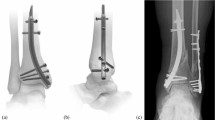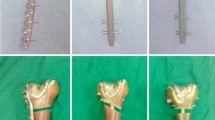Abstract
Purpose
Surgical treatment of distal tibial fractures demands a stable fracture fixation while minimizing the irritation to the soft tissues by approach and implant. Biomechanical studies have demonstrated superior performance for angular-stable locked nails over standard locked nails in distal tibial fractures. The experimental Retrograde Tibial Nail (RTN) is a minimally invasive local intramedullary osteosynthesis, which has been under design by our group. We conducted a biomechanical comparison in composite tibiae of the Retrograde Tibial Nail against the Expert Tibial Nail (Synthes®). Our hypothesis was that the RTN would provide equivalent biomechanical stability with respect to extra-axial compression, torsion and load to failure testing, in an extra-articular distal tibia fracture model.
Methods
Biomechanical composite bone testing was conducted in 14 biomechanical composite tibiae in an AO 43 A3 fracture model. In both groups, triple angle stable interlocking was performed in the distal fragment.
Results
Results show a statistically non-significant higher stability of the ETN during the axial loading tests. Torsional stability testing resulted in a statistically superior performance for the RTN (p = 0.018).
Destructive extra-axial compression resulted in failure of six ETN constructs, while all RTN specimens survived the maximal load.
Conclusions
The experimental Retrograde Tibial Nail provides the key features for the treatment of distal tibial fractures. It combines a minimally invasive local intramedullary osteosynthesis with the ability to securely fix the fracture by multiple angle stable locking options.





Similar content being viewed by others
References
Im GI, Tae SK (2005) Distal metaphyseal fractures of tibia: a prospective randomized trial of closed reduction and intramedullary nail versus open reduction and plate and screws fixation. J Trauma 59(5):1219–1223, discussion 1223
Vallier HA, Cureton BA, Patterson BM (2011) Randomized, prospective comparison of plate versus intramedullary nail fixation for distal tibia shaft fractures. J Orthop Trauma 25(12):736–741. doi:10.1097/BOT.0b013e318213f709
Iqbal HJ, Pidikiti P (2013) Treatment of distal tibia metaphyseal fractures; plating versus intramedullary nailing: a systematic review of recent evidence. Foot Ankle Surg: Off J Eur Soc Foot Ankle Surg 19(3):143–147. doi:10.1016/j.fas.2013.04.007
Ding M, Odgaard A, Linde F, Hvid I (2002) Age-related variations in the microstructure of human tibial cancellous bone. J Orthop Res 20(3):615–621
Hontzsch D, Blauth M, Attal R (2011) Angle-stable fixation of intramedullary nails using the Angular Stable Locking System(R) (ASLS). Oper Orthop Traumatol 23(5):387–396. doi:10.1007/s00064-011-0048-4
Gueorguiev B, Wahnert D, Albrecht D, Ockert B, Windolf M, Schwieger K (2010) Effect on dynamic mechanical stability and interfragmentary movement of angle-stable locking of intramedullary nails in unstable distal tibia fractures: a biomechanical study. J Trauma 70(2):358–365. doi:10.1097/TA.0b013e3181dbaaaf
Horn J, Linke B, Hoentsch D, Gueorguiev B, Schwieger K (2009) Angle stable interlocking screws improve construct stability of intramedullary nailing of distal tibia fractures: a biomechanical study. Injury 40(7):767–771
Wahnert D, Stolarczyk Y, Hoffmeier KL, Raschke MJ, Hofmann GO, Muckley T (2012) The primary stability of angle-stable versus conventional locked intramedullary nails. Int Orthop 36(5):1059–1064. doi:10.1007/s00264-011-1420-6
Wahnert D, Stolarczyk Y, Hoffmeier KL, Raschke MJ, Hofmann GO, Muckley T (2013) Long-term stability of angle-stable versus conventional locked intramedullary nails in distal tibia fractures. BMC Musculoskelet Disord 14:66. doi:10.1186/1471-2474-14-66
Gueorguiev B, Ockert B, Schwieger K, Wahnert D, Lawson-Smith M, Windolf M, Stoffel K (2011) Angular stability potentially permits fewer locking screws compared with conventional locking in intramedullary nailed distal tibia fractures: a biomechanical study. J Orthop Trauma 25(6):340–346. doi:10.1097/BOT.0b013e3182163345
Kaspar K, Schell H, Seebeck P, Thompson MS, Schutz M, Haas NP, Duda GN (2005) Angle stable locking reduces interfragmentary movements and promotes healing after unreamed nailing. Study of a displaced osteotomy model in sheep tibiae. J Bone Joint Surg Am 87(9):2028–2037. doi:10.2106/JBJS.D.02268
Kuhn S, Appelmann P, Pairon P, Mehler D, Rommens PM (2013) The Retrograde Tibial Nail: presentation and biomechanical evaluation of a new concept in the treatment of distal tibia fractures. Injury. doi:10.1016/j.injury.2013.10.025, in press
Hansen M, Mehler D, Hessmann MH, Blum J, Rommens PM (2007) Intramedullary stabilization of extraarticular proximal tibial fractures: a biomechanical comparison of intramedullary and extramedullary implants including a new proximal tibia nail (PTN). J Orthop Trauma 21(10):701–709
Horwitz DS, Bachus KN, Craig MA, Peters CL (1999) A biomechanical analysis of internal fixation of complex tibial plateau fractures. J Orthop Trauma 13(8):545–549
Augat P, Burger J, Schorlemmer S, Henke T, Peraus M, Claes L (2003) Shear movement at the fracture site delays healing in a diaphyseal fracture model. J Orthop Res 21(6):1011–1017. doi:10.1016/S0736-0266(03)00098-6
Epari DR, Kassi JP, Schell H, Duda GN (2007) Timely fracture-healing requires optimization of axial fixation stability. J Bone Joint Surg Am 89(7):1575–1585. doi:10.2106/JBJS.F.00247
Robinson CM, McLauchlan GJ, McLean IP, Court-Brown CM (1995) Distal metaphyseal fractures of the tibia with minimal involvement of the ankle. Classification and treatment by locked intramedullary nailing. J Bone Joint Surg Br 77(5):781–787
Kuhn S, Hansen M, Rommens PM (2008) Extending the indications of intramedullary nailing with the Expert Tibial Nail. Acta Chir Orthop Traumatol Cech 75(2):77–87
Court-Brown CM, Gustilo T, Shaw AD (1997) Knee pain after intramedullary tibial nailing: its incidence, etiology, and outcome. J Orthop Trauma 11(2):103–105
Katsoulis E, Court-Brown C, Giannoudis PV (2006) Incidence and aetiology of anterior knee pain after intramedullary nailing of the femur and tibia. J Bone Joint Surg Br 88(5):576–580
Keating JF, Orfaly R, O’Brien PJ (1997) Knee pain after tibial nailing. J Orthop Trauma 11(1):10–13
Toivanen JA, Vaisto O, Kannus P, Latvala K, Honkonen SE, Jarvinen MJ (2002) Anterior knee pain after intramedullary nailing of fractures of the tibial shaft. A prospective, randomized study comparing two different nail-insertion techniques. J Bone Joint Surg Am 84-A(4):580–585
Vallier HA, Cureton BA, Patterson BM (2012) Factors influencing functional outcomes after distal tibia shaft fractures. J Orthop Trauma 26(3):178–183. doi:10.1097/BOT.0b013e31823924df
Gardner MP, Chong AC, Pollock AG, Wooley PH (2010) Mechanical evaluation of large-size fourth-generation composite femur and tibia models. Ann Biomed Eng 38(3):613–620. doi:10.1007/s10439-009-9887-7
Heiner AD (2008) Structural properties of fourth-generation composite femurs and tibias. J Biomech 41(15):3282–3284. doi:10.1016/j.jbiomech.2008.08.013
Conflict of interest
The authors declare that they have no conflict of interest.
Author information
Authors and Affiliations
Corresponding author
Rights and permissions
About this article
Cite this article
Kuhn, S., Appelmann, P., Pairon, P. et al. A new angle stable nailing concept for the treatment of distal tibia fractures. International Orthopaedics (SICOT) 38, 1255–1260 (2014). https://doi.org/10.1007/s00264-013-2267-9
Received:
Accepted:
Published:
Issue Date:
DOI: https://doi.org/10.1007/s00264-013-2267-9




